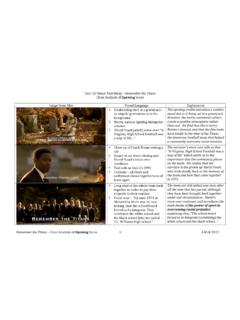Transcription of The McGraw-Hill Film Viewer’s Guide
1 The McGraw-Hill film Viewer s Guide David Bordwell University of Wisconsin The McGraw-Hill film Viewer s Guide David Bordwell Published by McGraw-Hill , an imprint of The McGraw-Hill Companies, Inc., 1221 Avenue of the Americas, New York, NY 10020. Copyright 2006, 2004, 2001 by The McGraw-Hill Companies, Inc. All rights reserved. The contents, or parts thereof, may be reproduced in print form solely for classroom use with film Art: An Introduction provided such reproductions bear copyright notice, but may not be reproduced in any other form or for any other purpose without the prior written consent of The McGraw-Hill Companies, Inc.
2 , including, but not limited to, in any network or other electronic storage or transmission, or broadcast for distance learning. 1 2 3 4 5 6 7 8 9 0 DOC/DOC 0 9 8 7 6 5 4 3 ISBN 0-07-248457-8 CONTENTS Chapter 1 Watching Films 1 What to Watch For 1 The Whole film 1 At the Very Start: Logos and opening Credits 3 4 Where to Watch 5 The Theater Experience 5 Home Video 6 DVD and Cable: Behind the Scenes 7 Movies on the Internet 8 Internet Movie Sites 9 Local film Culture 9 How to Watch 11 Developing Memory and Taking Notes 11 Chapter 2 W riting about Films 13 The Screening Report 13 Key Questions for a Screen Report 14 The film review 15 Key Questions for a film review 17 The Analytical Essay 18 Preparing to Write 18 Organization and Writing 22 Key Questions for an Analytical Essay 26 A Sample Analytical Essay 27 Writing Resources 32 Library Sources 32 The Internet 33 iii WRITING ABOUT FILMS 1 CHAPTER Watching
3 Films What to Watch For 1 T he Whole film film Art emphasizes that to appreciate a movie you have to consider it as a whole. Some parts may be intriguing in themselves, but the film operates as a total system, and any part gains its full meaning in that context. This is why we introduce the concepts of overall form (Part Two) and style (Part Four). Whether you re watching a film for diversion or for deeper understanding, as part of an evening s entertainment or as a class assignment, you ll appreciate the film most fully if you have an overall sense of how it s put together. This means developing the habit of thinking of any part, no matter how small, in relation to the rest of the film .
4 For example, two lines of dialogue from Jerry Maguire have entered everyday American English. Show me the money! has become a clich , while You complete me has been parodied in comedy skits. Taken by themselves, they are easy to mock. In the overall film , however, they play complicated roles. Show me the money! is at first an amusing line that Rod Tidwell uses to make Jerry swear he ll serve as a good agent for him. Rod wants to amass money to keep his family secure in the years when he can no longer play football. This is a businesslike attitude, but we ve already seen that one side of Jerry doesn t want the sports business to be wholly about money.
5 He has glimpsed the possibility of actually serving his clients as friends. So even though Jerry agrees to help Rod get a bigger paycheck, we can anticipate 1 2 CHAPTER 1a conflict coming up. As the plot develops, Rod will learn that his search for bigger paychecks demands that he think not only of himself and his family but his team. You complete me first appears when Jerry and Dorothy have quit the firm they work for and watch a loving deaf-mute couple sign to each other. Dorothy knows American Sign Language and can interpret their gestures a piece of knowledge that tells us that she s a sympathetic person. More generally, the line works as a summation of both Dorothy s and Jerry s situations.
6 She is moved by his mission statement, which shows that her idealism finds an outlet in his dream of a personalized sports agency. Jerry, on the other hand, must come to understand what Dorothy offers him. He loves her son and she has bolstered his confidence, but he is not ready to love her fully. Dorothy guides him toward becoming, in her words, the man he almost is. By the end of the film , when he declares, You complete me in front of a room full of women with unhappy relationships, he admits that he needs her to fulfil the best side of himself. As with Show me the money! the line gains its deepest meaning in the overall development of the plot.
7 The overall context of a movie can make any element significant. Consider credit sequences. At a minimum, credits can set a mood, like an overture in an opera or stage musical. The thunderous, looming title credit of Terminator 2: Judgment Day is stamped in flame-licked steel plates that slowly enlarge while metallic percussion hammers out a frantic pulse. The shot evokes the flames of nuclear war, the danger of physical action, a battle against machines, and the film s concern with humanizing its cyborg. By contrast, as we point out in film Art (p. 553), the candybox credits of Meet Me in St. Louis evoke nostalgia for cozy family life at the turn of the last century.
8 For Se7en, David Fincher wanted to set up anxiety in the spectator from the start, especially since the villain appears rather late in the film , so he commissioned graphic designer Kyle Cooper to create fast-cut, scratch-and-burn credits which suggest mutilation and madness. 2 WRITING ABOUT FILMS 3 At the Very Start: Logos and opening Credits Most theatrical motion pictures begin in a standardized way. First are the logos identifying the distributor and the production company. The major distributors have logos known around the world the Paramount mountain, the MGM lion, Columbia s Lady Liberty, the Warner Bros. shield, the Universal globe, and the enormous futuristic letters of Twentieth Century Fox.
9 The production company responsible for the film also tries to present a vivid, memorable image, as when Spielberg s Amblin Company recycles the silhouette of the bicycle against the moon from ET. In addition, an introductory logo can play a formal, stylistic, or thematic role in the film . The Paramount peak dissolves into a real mountain at the beginning of Raiders of the Lost Ark, and in the opening of The Matrix the Warners shield loses its bright blue and yellow tones and becomes a gloomy circuit-board green suitable for the cyberspace adventure which follows. Until the 1950s, a feature film followed a set format: lengthy credits at the very start, a The End title at the close, often followed by a shot listing cast members and their roles.
10 In the 1950s, some films began to have precredits sequences, one or two scenes which whetted the viewer s interest before the opening credits. Later filmmakers hit upon one strategy that s still common: Start the plot immediately but present the credits superimposed over the action we see, as in Jerry Maguire. Likewise, few films today include a The End title, since a long fade-out and a surge of music are enough to suggest that the plot has finished. For many decades the credits listed were quite selective. Nearly all of the hundreds of workers who participated in making the film were long-term studio employees, and so they went uncredited.













